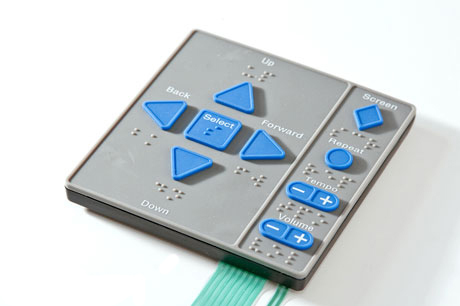How Membrane Switch Technology is Revolutionizing User Interfaces
How Membrane Switch Technology is Revolutionizing User Interfaces
Blog Article
Understanding Membrane Layer Switches Over: The Trick to Long Lasting and Reputable Controls

What Are Membrane Layer Switches?
Membrane switches are a sophisticated service in the realm of individual interface technology, integrating functionality and layout seamlessly. These tools work as a user interface in between users and electronic systems, incorporating several elements into a compact style. Typically created from flexible, slim layers of materials, membrane layer switches are developed to reply to touch, making it possible for users to connect with equipment and electronic devices successfully.
The key components of a membrane button include a printed circuit layer, graphic overlay, and a spacer layer that stops unintended activation. The visuals overlay can be tailored to show brand identity or customer choices, boosting visual appeals while ensuring functionality. Membrane buttons are generally utilized in numerous applications, consisting of clinical devices, customer electronics, and commercial tools, owing to their longevity and resistance to environmental elements such as wetness and dirt.
Among the vital advantages of membrane switches is their capability to withstand deterioration, making them ideal for high-traffic settings. Additionally, they are light-weight and call for marginal room, permitting innovative designs in product growth. In general, membrane switches represent a sensible and reliable selection for modern electronic interfaces, marrying technology with user-centric layout concepts.
How Membrane Changes Job
The procedure of membrane layer changes depend upon a simple yet reliable system that translates individual input right into electronic signals. These switches include numerous layers, generally consisting of a graphic overlay, a spacer layer, and a circuit layer. When a customer presses the switch, the top layer flaws, allowing a conductive aspect in the circuit layer to make contact with an equivalent conductive pad on the underside of the visuals overlay. This get in touch with shuts the circuit and sends an electronic signal to the device, indicating that the button has been turned on.
The design of membrane layer buttons can vary, but they frequently incorporate domes or tactile aspects to offer responses to the user, enhancing the total experience - membrane switch. The products used in membrane layer buttons, such as polyester or polycarbonate, add to their resilience and resistance to environmental aspects, consisting of wetness and dust. Additionally, the published circuits are normally enveloped, Read Full Report which safeguards them from damage gradually.
Advantages of Membrane Layer Buttons

Additionally, membrane switches are known for their longevity. Built from durable products, they are resistant to dust, wetness, and physical go to this website wear, which dramatically prolongs their lifespan contrasted to typical mechanical buttons. This longevity makes them specifically suitable for high-traffic environments and applications requiring long life.
Another substantial benefit is the convenience of cleaning and upkeep. The smooth surface area of membrane layer switches over minimizes dust build-up and is typically unsusceptible spills, making them ideal for setups that require frequent sanitization.
In addition, membrane layer buttons use a structured profile, leading to a thinner style that can be integrated right into numerous tools without including bulk. This function not just enhances the visual appeal but likewise contributes to an extra ergonomic product layout.
Applications of Membrane Layer Switches
Straightforward and functional, membrane switches discover applications throughout a variety of sectors, consisting of medical gadgets, consumer electronics, and commercial tools. In the medical field, these switches are indispensable to gadgets such as analysis devices, person tracking systems, and mixture pumps, where integrity and simplicity of cleaning are crucial. Their capacity to withstand harsh atmospheres and keep functionality makes them ideal for such applications.

In consumer electronic devices, membrane layer buttons are made use of in products like microwaves, washing machines, and remotes - membrane switch. Their streamlined style permits user-friendly interface, boosting the general customer experience while giving durability and resistance to tear and use
Industrial tools likewise gains from membrane switches, particularly in control panels for machinery and automation systems. These buttons offer defense versus dust and wetness, guaranteeing regular performance in difficult settings. Their personalized attributes allow manufacturers to tailor them to particular operational needs, enhancing efficiency and performance.
Selecting the Right Membrane Change
When choosing a membrane switch, it is necessary to think about different aspects that influence performance and suitability for specific applications. The primary factors to consider consist of ecological conditions, tactile feedback, resilience, and design specifications.
First, assess the operating environment; buttons subjected to wetness, chemicals, or extreme temperature levels need specific products to make see this here certain durability and performance. Next, review the demand for tactile feedback. Relying on customer interaction, some applications may gain from a tactile reaction to validate activation, while others might choose a non-tactile design for visual reasons.
Resilience is an additional important element; membrane buttons should be made to stand up to frequent usage, effects, and abrasion. Ensure the chosen switch can sustain the expected lifecycle, specifically in high-usage situations.

Conclusion
In conclusion, membrane switches over serve as crucial components in the layout of reliable and long lasting control systems throughout various markets. The convenience of membrane changes enables for customized services that satisfy details operational requirements, reinforcing their importance in modern-day innovation.
Membrane changes stand for a crucial element of modern-day user interface style, blending performance with strength in various applications.Membrane layer buttons are an advanced solution in the world of individual interface modern technology, combining functionality and style effortlessly. Generally built from adaptable, slim layers of materials, membrane switches are developed to react to touch, making it possible for customers to interact with machinery and electronic gadgets properly.
The layout of membrane layer buttons can vary, however they usually integrate domes or tactile components to offer feedback to the user, enhancing the overall experience.In final thought, membrane layer switches over serve as necessary parts in the layout of dependable and sturdy control systems across numerous industries.
Report this page